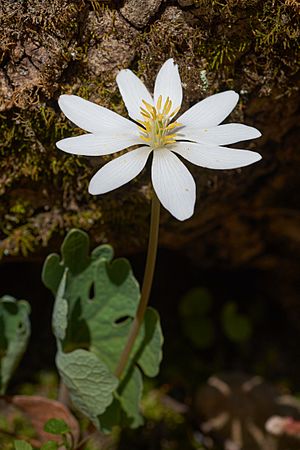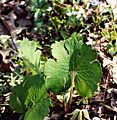Sanguinaria facts for kids
Quick facts for kids BloodrootSanguinaria canadensis |
|
|---|---|
 |
|
| Conservation status | |
| Scientific classification | |
| Genus: |
Sanguinaria
|
| Species: |
canadensis
|
Sanguinaria canadensis, also known as bloodroot, is a beautiful perennial flowering plant. This means it lives for more than two years and grows new stems each spring. It is native to eastern North America. Bloodroot is the only species in its plant group, called Sanguinaria. It belongs to the Papaveraceae family, which also includes poppies.
This plant gets its name, bloodroot, from the reddish-orange sap found in its roots. Other names for it include Canada puccoon and redroot. While some old beliefs suggested it could treat illnesses, modern science does not support these claims. It's important to know that the plant's sap is poisonous if eaten.
Contents
What Bloodroot Looks Like
Bloodroot plants usually grow about 20 to 50 centimeters (8 to 20 inches) tall. Each plant has one large leaf that can spread up to 25 centimeters (10 inches) wide. This leaf has five to seven rounded sections, like fingers.
The leaves and flowers grow from a reddish root system called a rhizome. This rhizome grows just below the soil surface and has bright orange sap. The name Sanguinaria comes from a Latin word meaning "bloody," because of this colorful sap. Over time, the rhizomes grow longer and branch out, forming groups of plants.
Bloodroot Flowers and Seeds
Bloodroot flowers appear early in spring, usually from March to May. They bloom even before the leaves fully open. Each flower has 8 to 12 soft white petals and many yellow parts called stamens. There are also two small green parts called sepals below the petals, which fall off quickly.
The flowers open when the sun shines on them. Small bees and flies help pollinate them. After the flowers are pollinated, green pods grow, holding the seeds. These pods are about 4 to 6 centimeters (1.5 to 2.5 inches) long. The seeds inside are round and turn black or orange-red when they are ready. They have a special white part called an elaiosome that ants love to eat.
- Stages in the life of bloodroot
Where Bloodroot Grows
Bloodroot is found across eastern North America. It grows from Nova Scotia, Canada, all the way south to Florida, United States. You can also find it west towards the Great Lakes and down the Mississippi embayment.
These plants like to grow in moist or dry forests and thickets. They are often found in areas that flood, or near rivers and streams on hillsides. Sometimes, you might see them in open clearings or meadows. Deer might nibble on these plants in early spring.
How Bloodroot Spreads
Bloodroot is one of many plants that rely on ants to spread its seeds. This process is called myrmecochory. The seeds have a tasty, fleshy part called an elaiosome that attracts ants.
The ants carry the seeds back to their nests to eat the elaiosomes. After eating, they leave the seeds in their nest's leftover materials. This protects the seeds until they can grow. The seeds also benefit from the rich soil created by the ant nest.
Pollination and Visitors
Bloodroot flowers produce pollen, but they do not make nectar. Many different bees and flies visit the flowers, hoping to find nectar. These visitors include sweat bees, cuckoo bees, small carpenter bees, and bee flies.
Some bees come to collect pollen, like mining bees. These mining bees are very good at helping the flowers make new seeds. The leaves and roots of bloodroot taste bitter and are not often eaten by animals like deer.
Growing Bloodroot in Gardens
People sometimes grow Sanguinaria canadensis in their gardens because it is a lovely ornamental plant. Gardeners especially like the forms with double-flowered blooms. These flowers have many extra petals and look very showy.
Normal bloodroot flowers lose their petals quickly, often within a day or two after being pollinated. But the double-flowered types bloom for much longer. Their extra petals come from parts that would normally be stamens. A special double-flowered type called S. canadensis f. multiplex 'Plena' has even won an award for its beauty.
Is Bloodroot Safe?
Bloodroot contains natural chemicals called benzylisoquinoline alkaloids. The main one is a toxin called sanguinarine. These chemicals are stored in the plant's roots.
Sanguinarine can harm animal cells. Because of this, putting bloodroot on the skin can damage tissue. This can lead to the formation of dead tissue, which is called an eschar. Some people have mistakenly tried to use bloodroot products, like black salve, as a home treatment for skin problems. However, these attempts can cause serious and lasting damage to the skin. These products do not remove harmful growths and can leave behind damaged tissue.
It is not safe to use bloodroot internally (by eating or drinking it). Taking too much bloodroot extract can cause vomiting and even make someone lose consciousness.
How Bloodroot Has Been Used
Bloodroot has a few interesting uses.
Commercial Products
Some products, like certain toothpastes and mouthwashes, use sanguinarine or bloodroot extract.
Natural Dye
Bloodroot is a popular red natural dye. Many Native American artists have used it, especially those who make baskets from rivercane. If you break the surface of the plant, especially the roots, you will see the reddish sap that can be used to make this dye.









